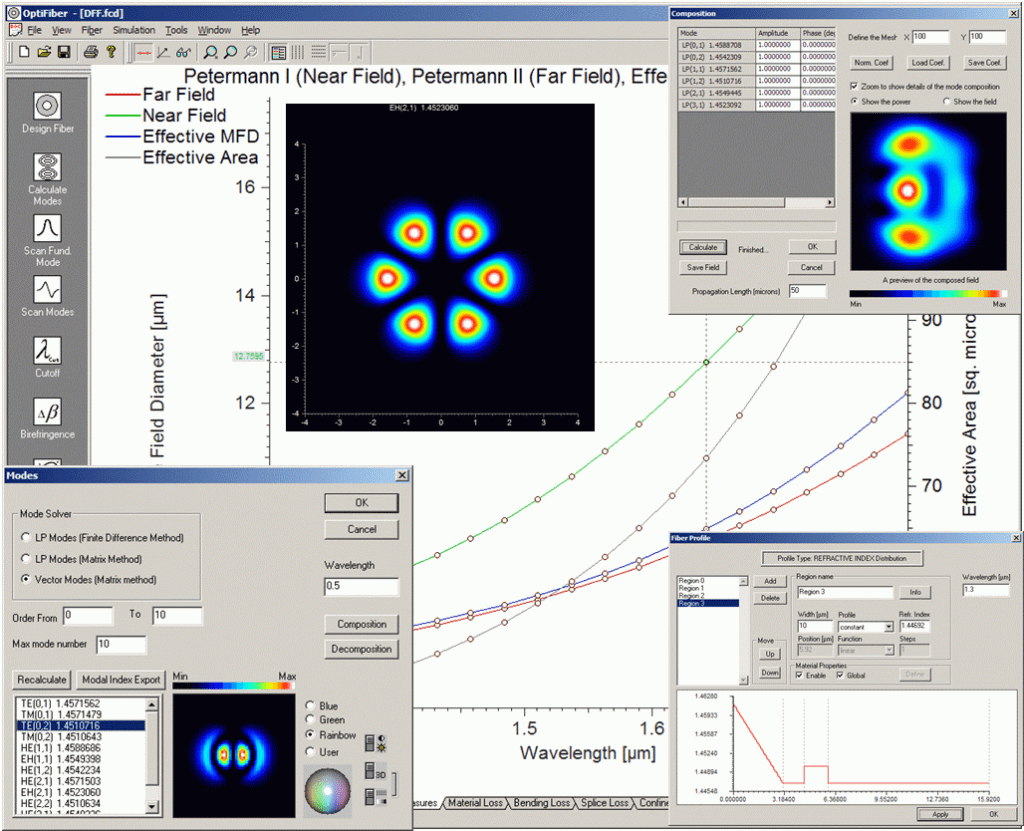OPTIWAVE
SPECTROPOL is the distributor of the Canadian company Optiwave, a company with 30 years of experience in creating groundbreaking software tools adapted to the design, simulation and optimization in the constantly developing areas of photonic nanotechnology, optoelectronics and optical networks.
Optiwave software is used by over 1000 scientific, research and industrial institutions in 80 countries around the world.
OptiFiber: Modern Fiber Optic Design
In what areas is OptiFiber used?
Optimal design of an optical communication system is directly dependent on the choice of fiber parameters. The cross-sectional dimensions of the fiber, the material composition, and the refractive index profile all affect important linear and nonlinear phenomena. OptiFiber uses numerical mode solutions and other specialized fiber models to calculate dispersion, loss, birefringence, and polarization mode dispersion (PMD).
OptiFiber’s ability to help manufacturers optimize a specific design based on their goals opens the door to a variety of applications, from simple simulations of single-mode fibers to supporting real lab instruments such as the NR-9200 fiber analyzer. OptiFiber combines an intuitive user interface with an impressive feature set, providing a seamless experience for engineers, scientists, and students.
Most popular applications
- Evaluation of parameters, sensitivity and tolerance
- Resolving LP or vector fiber modes using finite difference or transfer matrix methods
- Analysis of measured fiber profiles from instruments such as the EXFO NR-9200
- Automatic parameter scanning
- Design of fiber sensors
- Design of single-mode fibers such as Corning SMF-28, dispersion-modified or flattened fibers
- Design of multi-mode fibers such as 50/125 µm and 62.5/125 µm silicon fibers
- Visualization of multi-mode interference patterns with propagation
- Calculation of birefringence and PMD from internal or external perturbations
OptiFiber Characteristics
Integrated Environment
OptiFDTD offers a complete and user-friendly 3D graphical interface for designing, simulating, and analyzing complex devices. Designs from external CAD software can be easily imported and exported using popular formats such as DXF and GDSII.
OptiFDTD and OptiBPM can work seamlessly together, expanding the scope of simulation achievable using OptiFDTD alone. Integrating this FDTD tool with other Optiwave solutions further accelerates time-to-market for engineers.

Optimal Design of Optical Communication Systems
Optimal design of optical communication system directly depends on the choice of fiber parameters. The dimensions of the fiber cross-section, material composition and refractive index profile affect important linear and nonlinear phenomena. OptiFiber uses numerical mode solutions and other specialized fiber models to calculate dispersion, loss, birefringence and PMD (polarization mode dispersion).
Meshless Mod Solutions for LP and Vector Mods
Optical fibers can consist of any number of concentric layers of materials without loss, and fibers with a variable refractive index can be approximated as sequences of layers with a constant index. OptiFiber 2.0 mode solvers find an exact solution by matching boundary conditions at the layer boundaries, rather than relying on grids to approximate the structure.
These advanced mode solvers are particularly useful in the calculation of multimodal fibers, where there are many modes in the spectrum.
An additional advantage of the grating-free mode solvers is the ability to calculate fields far from the fiber. Gratings introduce finite difference errors, and fields weaker than the difference error cannot be calculated. The grating-free mode solvers have correct asymptotic behavior far from the fiber and can calculate fields with magnitudes of 10^-15 or less.
This functionality complements the existing mode solvers in OptiFiber.
Propagation at a Distance
OptiFiber allows users to decompose any field into multimodal fiber modes. It calculates the complex mode coefficients for any field. Similarly, for a given amplitude of a set of modes, OptiFiber can display the sum (mode composition).
OptiFiber 2.0 can also calculate this multimodal field after propagation along the fiber over a specified distance. The user enters the distance. Each of the complex mode coefficients is multiplied by the appropriate phase factor, and the new field pattern is displayed in the preview window.
0:23 Optical Fiber Profile
0:45 Design Fiber
1:46 Tracking
2:31 Dispersion
OptiFiber Applications
Below is a list of selected scientific publications, technical journals, periodicals and conference proceedings that refer to the use of OptiFiber software. These references have been collected from internal sources, articles submitted by customers and scientific publications from Google Scholar. To the best of our knowledge, all of these works use the OptiFiber software package. If you notice any errors, please contact us immediately at info@spectropol.pl or info@optiwave.com.
- Highly Sensitive and Highly Emissive Luminescent Thermometers for Elevated Temperatures Based on Lanthanide-Doped Polymers https://www.mdpi.com/2304-6740/11/5/189
- Machine Learning Technique for Few-Mode Fiber Design with Inverse Modelling for 5G and Beyond https://doi.org/10.1007/978-981-99-0109-8_12
- DIFFERENTIAL EFFECTS OF NON-ABSORBABLE CARBOHYDRATES AND FOOD FIBERS ON THE MICROBIOTA HYDROGEN AND METHANE … https://www.researchgate.net/profile/Lusine-Danielyan-3/publication/374814474_Isolation_of_Probiotic_Bacteria_in_Breast_Milk_to_Improve_Breast_Milk_and_Infant_Gut_Microbiota/links/653113b65d51a8012b5499ba/Isolation-of-Probiotic-Bacteria-in-Breast-Milk-to-Improve-Breast-Milk-and-Infant-Gut-Microbiota.pdf#page=70
- Cost-Effective Solution to Siloed WWTP and CSO Administrative Orders https://www.accesswater.org/publications/proceedings/-10097625/cost-effective-solution-to-siloed-wwtp-and-cso-administrative-orders
- MDM over hyber FSO and fiber to the x FTTX https://scientificjournal.alqalam.edu.iq/index.php/AJPAS/article/download/220/32
- Domestic Advanced Primary Wastewater Treatment Utilizing Pile Coth Media Filtration for Operational Savings and Increased Biogas Production and Wet Weather … https://www.accesswater.org/publications/proceedings/-10097515/domestic-advanced-primary-wastewater-treatment-utilizing-pile-coth-media-filtration-for-operational-savings-and-increased-biogas-production-and-wet-weather-treatment
- Mode Division Multiplexing Bidirectional Transmission System using Double Clad Fiber for Mobile In-Building Solutions https://ieeexplore.ieee.org/abstract/document/10197803/
- On off keying line coding based optical transmitter for various both optical fiber communication and OWC channels https://doi.org/10.1515/joc-2023-0071
- COMPETITION ISSUES BETWEEN TV CHANNELS: ITS IMPACT ON SOCIETY http://ijmer.s3.amazonaws.com/pdf/volume12/volume12-issue10(4)/6.pdf
- Simulative study of high speed light modulated measured sources for high optical network transmission efficiency https://doi.org/10.1515/joc-2023-0003
- Simulative study of vertical cavity with distributed feedback optical sources coupling to fiber systems evaluation https://doi.org/10.1515/joc-2023-0017
- Integrated optics based on electro optic modulators for long distance links and high bit rate communication https://doi.org/10.1515/joc-2023-0013
- Distributed feedback laser grating order effects on optical systems with NRZ-RZ line coding scheme performance signature https://doi.org/10.1515/joc-2023-0072
- The efficient employment of the space division multiplexing technique with OADMs for more flexibility and scalability in optical systems https://doi.org/10.1515/joc-2023-0024
- Arquitectura de una red FTTH con tecnología GPON para habilitar el servicio de internet en el centro poblado de Comatrana, Ica 2022 http://repositorio.unac.edu.pe/handle/20.500.12952/7791
Free trial
Take advantage of the 30-day opportunity to test the Optiwave software. Sign up now!
